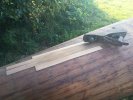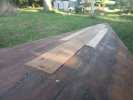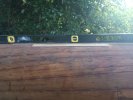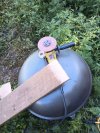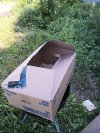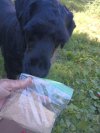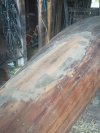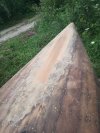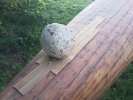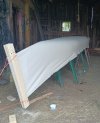Mud Bug
Hand made things are better
Thanks, Worth. I think a date is more important than a name. I sure would like to know when my canoe was last repaired.
Here's another small problem this canoe had. I should have asked folks here how to fix it before I barreled ahead and just did it, but I didn't. Feel free to tell me why this won't work even though I did it already.
This old canoe had, well I don't know what you call it, a sunken area in the hull right under the rear seat just off the stem. It sagged in, or sucked up, a quarter of an inch. I don't like a saggy canoe. I had no idea how I could possibly push the ribs and planking back out again. And if I replaced them it'd probably come out looking far worse than the sag, so I decided to leave it alone and just fill it in. I laid my level over it to see were the sag started and stopped and how deep the sag was. It was almost exactly a quarter inch, which is the thickness of some planking I had on hand, so I cut some that length and glued it down with brass tacks holding it til the glue took ahold. The next day, when the glue was solid, I pulled the tacks and planed the planking until it agreed with the level and nowhere was sunken anymore. That left the planking pretty thin on the ends but 1/4" thick in the middle, but it's all glued down. I hope it keeps on sticking.
I'm really curious to know how you real canoe repairmen deal with a sag like this. I have a '36 Yankee that's a whole lot worse, and I'm skeptical that this method'll save it.
Here's another small problem this canoe had. I should have asked folks here how to fix it before I barreled ahead and just did it, but I didn't. Feel free to tell me why this won't work even though I did it already.
This old canoe had, well I don't know what you call it, a sunken area in the hull right under the rear seat just off the stem. It sagged in, or sucked up, a quarter of an inch. I don't like a saggy canoe. I had no idea how I could possibly push the ribs and planking back out again. And if I replaced them it'd probably come out looking far worse than the sag, so I decided to leave it alone and just fill it in. I laid my level over it to see were the sag started and stopped and how deep the sag was. It was almost exactly a quarter inch, which is the thickness of some planking I had on hand, so I cut some that length and glued it down with brass tacks holding it til the glue took ahold. The next day, when the glue was solid, I pulled the tacks and planed the planking until it agreed with the level and nowhere was sunken anymore. That left the planking pretty thin on the ends but 1/4" thick in the middle, but it's all glued down. I hope it keeps on sticking.
I'm really curious to know how you real canoe repairmen deal with a sag like this. I have a '36 Yankee that's a whole lot worse, and I'm skeptical that this method'll save it.

